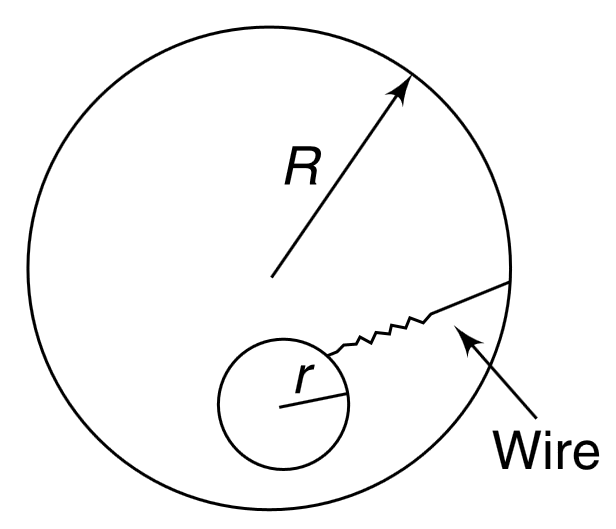A zinc ball of radius, R=1 cm charged to a potential -0.5 V. The ball is illuminated by a monochromatic ultraviolet (UV) light with a wavelength 290 nm. The photoelectric threshold for zinc is 332 nm. The potential of ball after a prolonged exposure to the UV is
Step by step video & image solution for A zinc ball of radius, R=1 cm charged to a potential -0.5 V. The ball is illuminated by a monochromatic ultraviolet (UV) light with a wavelength 290 nm. The photoelectric threshold for zinc is 332 nm. The potential of ball after a prolonged exposure to the UV is by Physics experts to help you in doubts & scoring excellent marks in Class 12 exams.
Topper's Solved these Questions
- BOOK - KVPY PREVIOUS YEARCHAPTER - KVPY 2021EXERCISE - PART II PHYSICS9videos
KVPY 2021
- BOOK - KVPY PREVIOUS YEARCHAPTER - KVPY 2021EXERCISE - PART I (Chemistry)2videos
KVPY 2021
- BOOK - KVPY PREVIOUS YEARCHAPTER - KVPY 2021EXERCISE - PART I (Chemistry)2videos
KVPY 2021
- BOOK - KVPY PREVIOUS YEARCHAPTER - KVPYEXERCISE - All Questions415videos
KVPY
- BOOK - KVPY PREVIOUS YEARCHAPTER - MOCK TEST 1EXERCISE - EXERCISE23videos
MOCK TEST 1
Similar Questions
An isolated copper sphere of radius 5.0 cm, initially uncharged, is illuminated by ultraviolet light of wave- length 200 nm. What charge will the photoelectric effect induce on the sphere. The work function for copper is 4.70 eV.
View Solution
A conducting ball of radius r is charged to a potential V0. It is enveloped by a thin walled conducting sphere of radius R (gt r) and the two spheres are connected by a conducting wire. Find the potential of the outer sphere.View Solution
Knowledge Check
- Question 1 - Select One
A copper ball of radius 1 cm and work function 4.47eV is irradiated with ultraviolet radiation of wavelength 2500 Å. The effect of irradiation results in the emission of electrons from the ball, Further the ball will acquire charge and due to this there will be a finite value of the potential on the ball. The charge acquired by the ball is :
A5.5×10−13CB7.5×10−13CC4.5×10−12CD2.5×10−11C - Question 2 - Select One
A certain metallic surface is illuminated with monochromatic light of wavelength λ . The stopping potential for photoelectric current for this light is 3V0 . If the same surface is illuminated with light of wavelength 2λ , the stopping potential is V0 . The threshold wavelength for this surface for photoelectric effect is
A4λBλ4Cλ6D6λ
When a metal plate is exposed to a monochromatic beam of light of wavelength 400nm, a negative potential of 1.1 V is needed to stop the photocurrent . Find the threshold wavelength for the metal.
View SolutionA metal has a work function of 2.0 eV and is illuminated by monochromatic light of wavelength 500nm. Calculate (a) the threshold wavelength (b) the maximum energy of photoelectrons (c) the stopping potential. [use h=6.63×10−34J,c=3×108ms−1]
View SolutionIn ultraviolet light of wavelength 200 nm is used in an experiment of photoelectric effect with lithium cathode (w = 2.5 eV). Then calculate
(i) K.Emax
(ii) Stoppiong potentialView SolutionIn a photoelectric experiment, the collector plate is at 2.0 V with respect to the emitter plate made of copper '(phi = 4.5)'. The emitter is illuminated by a source of monochromatic light of wavelength 200nm. Find the minimum and maximum kinetic energy of the photoelectrons reaching the collector.
View SolutionWhen a piece of metal is illuminated by monochromatic light of wavelength λ then the stopping potential for photoelectric current is 2.5 V0. When the same surface is illuminated by light of wavelength 1.5 λ, then the stopping potential becomes V0. Find the value of threshold wavelength for photoelctric emission.
View SolutionA certain metallic surface is illuminated with monochromatic light of wavelength λ. The stopping potential for photoelectric current for this light is 3V0. If the same surface is illuminated with light of wavelength 2λ, the stopping potential is V0∘ The threshold wavelength for this surface for photoelectric effect is yλ. Find y.
View Solution

